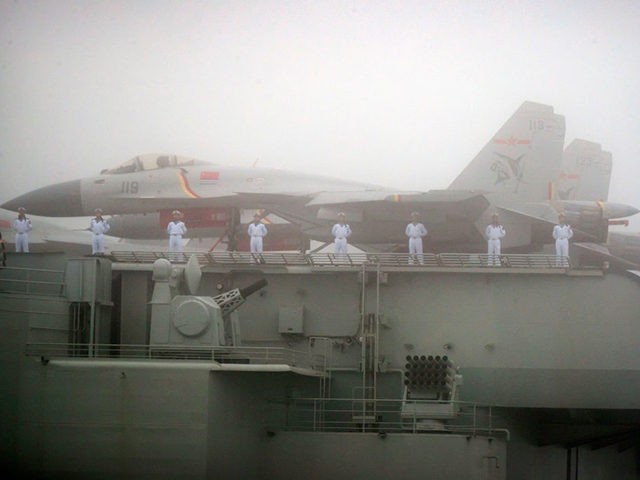Chinese Communist Party leader Xi Jinping on Tuesday attended the commissioning ceremony for the Shandong, China’s second aircraft carrier and the first to be constructed domestically.
The Shandong was commissioned at the Sanya navy base in Hainan Province in southern China in a ceremony on Tuesday after six years of construction and testing, including a shakedown cruise through the Taiwan Strait angrily interpreted by Taiwan as an intimidation effort.
AFP reported about 5,000 people attended the ceremony and sang the Chinese national anthem as the ship raised its flag. Xi met with members of the crew during his visit.
The People’s Liberation Army Navy (PLAN) of China is now one of the few military forces in the world to boast multiple aircraft carriers in service. China’s first carrier, the Liaoning, was purchased from Russia and retrofitted for service with the PLAN in 2012.
Shandong is considerably larger than Liaoning and can carry more planes, and it has more advanced electronics plus some structural improvements, but its design was based on the old Russian ship, including the old-fashioned “ski slope” launching ramp on the prow. China is working on a third carrier with a more original and modern design, including launch catapults comparable to those employed by American carriers.
AFP quoted analysts with differing opinions about the strategic impact of the new Chinese vessel:
With several Chinese carriers, the east coast of Taiwan may no longer be safe for Taiwan’s defenders,” said Steve Tsang, head of the China Institute at the School of Oriental and African Studies in London.
But it would take nearly a decade for the new carrier to be combat-ready, he added.
“The carriers do not really effect the balance of force between China and the U.S. — or Japan with its sophisticated sea and air capabilities,” said James Goldrick, a naval and maritime strategy expert at the Australian National University.
“They are extremely vulnerable to submarine attacks, particularly nuclear-powered submarines such as the U.S. Navy operates in the Western Pacific.
The South China Morning Post noted the new ship was supposed to be christened in April, but the ceremony was delayed because “its trial phase took longer than some military observers had expected, suggesting it had suffered technical problems.”
The SCMP quoted Chinese naval expert Li Jie explaining that the Sanya naval base was chosen to commission the Shandong because “military leadership wanted to highlight the geostrategic importance of China’s second aircraft carrier base,” with an emphasis on how Beijing can now project more naval power across the South China Sea. Also, the base is convenient to Macau, which is supposed to see the carrier as a “big gift” to celebrate the 20th anniversary of its return to Chinese control.
Other Chinese analysts said the carrier is clearly meant as a deterrent to Taiwanese independence and a message that Beijing is willing to fight a full-scale war to enforce its territorial claims across the region — a message that was not lost on Japanese Defense Minister Taro Kono, who on Monday denounced China for “unilateral and coercive attempts to alter the status quo in the East and South China Seas” and accused it of rapidly enhancing its nuclear and missile capabilities “without transparency.”

COMMENTS
Please let us know if you're having issues with commenting.